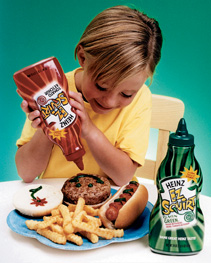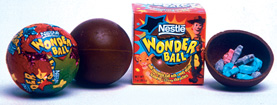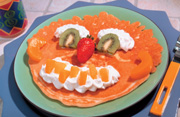
Yogurt makers have had tremendous success attuning themselves to kids by combining the element of fun with a time-pressed lifestyle. Fruit-flavored yogurt in squeeze tubes or single-serving cups appeal to kids' on-the-go natures. Colleen Fahey, executive vice president and kids marketing guru at Frankel, a Chicago-based brand marketing and promotions agency, believes today's tweens—so schedule-oriented that they carry planners—find fun foods on the run “appeal to their playful sides and their busy lives.”
Stonyfield Farms' Yosqueeze capitalized on this trend, and Kemp's Yo Stix from Marigold Foods, Minneapolis, also provides all the appeal of yogurt with the convenience of a tube, while the latter company's Spoonz 'N Yogurt features plastic spoons as an additional time-saver.
On the Run
As Fahey notes, “Snacks will continue to appeal to kids' on-the-go natures. Healthy foods like Milk Chugs, GoGurt, smoothies, and applesauce in tubes will keep popping up, but so will fun foods.”Companies should focus on the need for fun, especially in light of kid's increasingly busy schedules. “Eating with one hand is important to children, as they eat while they play video games, email, and do homework,” explains Fahey.
She believes children will be attracted to healthy foods, as long as the taste is there. Nonetheless, children's eating patterns have become a source of controversy. Critics of current industry practices find great fault with food companies targeting youngsters, particularly with food and beverage products that are not ideally suited—nutritionally—for growing bodies.
Maybe Not Running Enough
Noting a “drastic increase in type 2 diabetes among young people,” the U.S. Surgeon General believes about 14% of American children are too heavy, while 25% suffer from elevated cholesterol. A Yale study, published in the New England Journal of Medicine, found that 25% of obese children and 21% of obese adolescents tested were glucose intolerant and at high risk for developing diabetes.The obesity statistics and diabetes risks have prompted many companies to develop healthier snacking options for children. “There is nothing wrong with snacking,” says Denise Devine, founder and CEO of Devine Foods, Philadelphia. “If I were a large company, I would view it as a huge opportunity, because snack occasions are an opportunity to provide healthier alternatives for kids.”
Devine believes snacks for children will change, as the public's awareness of associated health problems magnifies. However, she believes the true impact of obesity is a decade or so away.
“There are all kinds of complications with that—including heart disease,” Devine states. “Obesity is one thing, but everything that comes from that has a list of problems.”
Devine uses fruit juice as an example of how a relatively healthy product can have unintended effects. Studies have shown that kids drinking fruit juice can face two less-than-ideal circumstances. They can fill up on it to the point of being full, whereby they don't eat properly and fail to get the correct nutrients needed to build strong muscles and bones. The other possibility is that the kids may still eat properly but put on extra weight. Devine sought to combat this by developing a beverage with a whole grain base (oats and barley), flavored with fruit. Devine says the drink is similar to a smoothie and is available in a little juice box.


The Power of Choice
Reaching the parent is only one aspect of building a successful children's snack, as the kids themselves increasingly are responsible for not only preparing but, also, purchasing their foods and beverages. This group has grown so financially powerful that companies can register a successful new product simply by attracting youngsters.Bear in mind that spending by children under the age of 12 tripled in the 1990s. In 1997, they spent more than $23 billion, according to the Center for a New American Dream, Takoma Park, Md. Youths between the ages of 12 and 19 accounted for almost $94 billion in sales in 1998, and none of these figures include the billions of dollars parents spend under the influence of their children.
Major food and beverage companies realize this, as evidenced by the abundance of ads targeting children. In Food Politics, Marion Nestle says businesses spend an estimated $13 billion a year marketing food and drinks to U.S. children. Nestle, chair of the Department of Nutrition and Food Studies at New York University, found that total had increased $5 billion over the past decade.
Margo Wootan, director of nutrition policy for the Center for Science in the Public Interest, says about half of all advertising aimed at children is for food, and four of those five ads are for sugary cereal, soft drinks, fast food or salty snacks. That fact likely will change, as consumer groups are already lining up to remove such advertising from schools (where vending machines are also in the crosshairs). Furthermore, plans are in motion to ban food advertising (or limit the foods advertised) during programming for young children.
